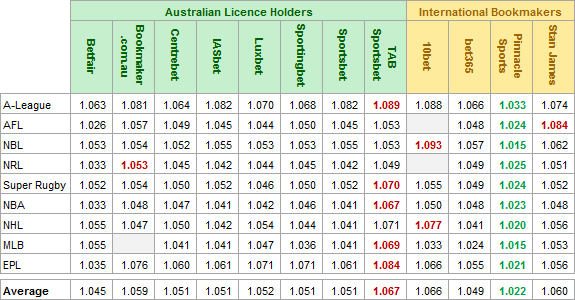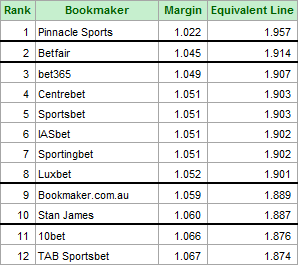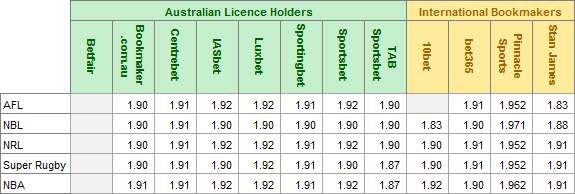UPDATE
This article has been superseded by a more recent survey.
View the 2023 bookmaker margin survey results.
This article provides a comparison of bookmaker margins from twelve popular services. It is a follow up to our 2011 bookmaker margin survey, which compared betting odds across various Australian and international bookmakers. This article summarises our 2012 survey, which includes a number of bookmakers that weren’t included in the previous study.
What are Bookmaker Margins?
The bookmaker margin is a measure of a bookmaker’s profit margin for an event, and can be regarded as a hidden transaction cost for punters. For example, in a coin toss where heads and tails each have a probability of 50%, a bookmaker won’t offer 2.00 odds on each outcome. It will instead offer odds of, say, 1.92. If equal wagers are placed on heads and tails, the bookmaker will secure a profit regardless of the result. This profit is how bookmakers finance their services, but they vary in the levels of margins used.
From a punter’s perspective, the lower the margin, the better. While the difference between 1.90 and 1.92 line odds may not seem significant for a single wager, when betting repeatedly this adds up, and it can make the difference between winning and losing money.
How to Calculate Bookmaker Margins
When using the decimal odds system, which is common in Australia and Europe, calculating the bookmaker margin for an event is easy. The margin equals the sum of the reciprocals of the the odds. Below are calculation examples using two- and three-outcome events.

How to Interpret Bookmaker Margins
The margin measures the bookmaker’s profit if it were to receive wagers on each outcome in proportion to the odds. Suppose a bookmaker offers odds a on outcome A and odds b on outcome B. If proportion b/(a+b) is wagered on A and a/(a+b) is wagered on B, then the bookmaker will receive the same profit regardless of the result, which is equal to the margin. This margin is amount by which the actual “book” exceeds 100%. For this reason, you will always get a value of at least 1.00.
For example, the bookmaker margin for the two-outcome event above is 1.035, or 103.5%. Suppose $100,000 in total is wagered on the market, with:
[1.64/(1.64 + 2.35)] x $100,000 = $41,102.76 wagered on Oklahoma City and
[2.35/(1.64 + 2.35)] x $100,000 = $58,897.24 wagered on Denver.
Depending on the outcome, the bookmaker will pay out one of the following two amounts:
|
If Oklahoma City wins: $41,102.75 x 2.35 = $96,591.48 The bookmaker took $100,000 in wagers, but only pays out $96,591.48. If we divide the intake by the outgoings we get $100,000/$96,591.48 = 103.5%, as calculated by the margin earlier. Obviously a bookmaker will rarely receive wagers that are perfectly in proportion to the odds, but over the countless number of markets offered the margin will equate to the bookmaker’s average profit margin across all events. To give some perspective on how odds relate to margins, the table on the right compares various equal line odds (bets with a 50% chance of winning) to their respective margins. Note that 2.00 odds equate to a margin of 1.00, where the bookmaker makes no profit on the market. |
 |
Bookmaker Margin Survey
Bookmaker margins have been calculated for twelve bookmakers that offer Australian dollar accounts. The margins in the table below reflect the average margin across a sample of events logged for each sport. The margins have been calculated for head to head, line, and over/under markets, where available. These margins have then been averaged to give a representative margin per sport.
In the summary table below, the lowest average margin for a given sport is highlighted in green, while the highest margin is highlighted in red. A blank cell means odds were not available for that particular sport at the time of review.

When we rank the bookmakers in ascending order of their average margin we get the following:

The bookmakers fall into five tiers:
- Pinnacle Sports is in a league of its own, with margins that are often half that of its competitors. Pinnacle Sports markets itself as a low margin bookmaker and our research validates that claim.
- Betfair (using 5% Betfair commissions) offers the second best value. It should be noted that because it is an exchange rather than a bookmaker, the margins vary depending on the popularity of the event. Popular events dominated this year’s survey, so Betfair scored well. For less popular events and markets Betfair can easily have margins that are higher than standard bookmakers.
- In the third bracket we have bet365 along with most of the popular Australian bookmakers.
- Next we have Bookmaker.com.au and Stan James, although it should be noted that Bookmaker.com.au is a new bookmaker. Its margins could well come down once it has launched its full market line up later in the year.
- The worst performers were 10bet.com and TAB Sportsbet, however 10bet.com’s results were heavily influenced by its high margins on the NBL. When excluding this league its average margin comes down to 1.061, promoting it to the fourth tier.
Line Survey
The table below summarises even lines surveyed for popular sports.

Pinnacle Sports is again the standout performer, with even lines of 1.952 offered on most sports.
Conclusions
This survey was a repeat of our 2011 margin survey, using 2012 odds and additional bookmakers.
Pinnacle Sports was again the stand out performer, with margins that were often half that of its competitors. The major Australian bookmakers offer similar value, while TAB Sportsbet offers the least value of the Australian bookmakers.
Keep in mind that higher margins enable bookmakers to offer better services. Pinnacle Sports offers a simple betting service, while a higher margin bookmaker like bet365 offers a flashier user interface, live video feeds and access to team statistics.
While high margins may deter you from obtaining membership with a particular bookmaker, it can still be beneficial to maintain an account with that service within a portfolio of memberships. This is because the bookmaker may still provide the best odds for a particular outcome. TAB Sportsbet frequently offers odds that are in contrast to other bookmakers, so while its margins are higher, it is often the best value for a particular selection. This was observed on numerous occasions during the data entry process for this survey. The same can be said for Stan James.
It should be noted that bookmaker margins for a particular bookmaker will vary from sport to sport. Popular leagues often entail lower margins. For example the average English Premier League margin across the surveyed bookmakers was 1.06, as opposed to 1.072 for the A-League. The average margin for the NBA was 1.045 as opposed to 1.054 for the NBL. This result is a combination of three things. First, the popular leagues are subject to more research and scrutiny by odds making services. This makes bookmakers more confident in their odds, enabling them to narrow the margin. Second, the more popular leagues are wagered on more heavily by punters than less popular sports. This added ‘liquidity’ makes it easier for bookmakers to adjust the odds and balance their books, so to speak, if punters initially favour one selection over another. This added liquidity implies less risk for bookmakers, enabling them to narrow the margin. Finally, when punters make casual comparisons of bookmaker odds, they are likely to compare odds for the more popular markets. A bookmaker would not wish to be seen offering poorer value on the headline markets such as the NRL and AFL, so they tend to be more competitive in these markets.
Not only do margins vary from league to league, but with some bookmakers they also vary from fixture to fixture. More popular fixtures, such as Man Utd vs Man City, will attract greater interest, which can result in lower margins for the reasons discussed in the previous paragraph.
Finally, please note that this survey was conducted in April and May 2012, and that the margin averages were heavily dependent on the sample of sporting events chosen. Comparative margin levels may change over time, and may differ for sports not covered in this survey.


